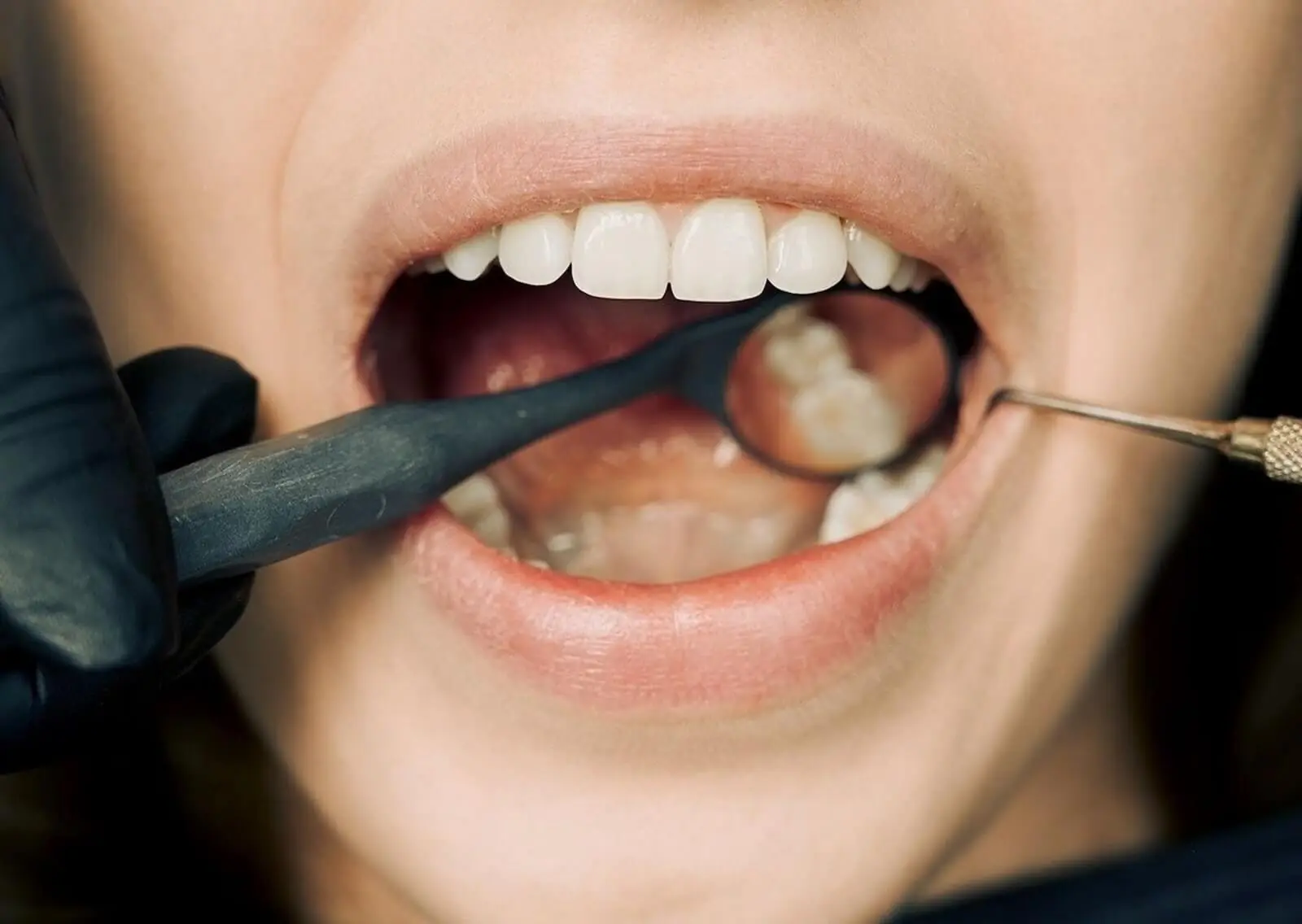Infected Gum after Wisdom Tooth Removal

An infected gum after wisdom tooth removal may present with pain, swelling, redness, and possibly discharge. Contact your dentist or oral surgeon promptly for evaluation and treatment.
They may prescribe antibiotics, recommend warm saltwater rinses, and provide guidance on proper oral hygiene and pain medication. In severe cases, your dentist may need to drain the infection or perform additional treatment.
Key Takeaways
- See your dentist right away if you suspect an infection. Symptoms include increasing pain, persistent swelling, fever, bad taste or smell, and discharge.
- Causes of infection: Dry socket, poor oral hygiene, pre-existing issues, complex extractions, and smoking can contribute.
- Treatment basics: Your dentist will likely prescribe antibiotics, clean the site, and recommend pain relievers and warm salt water rinses.
- Nerve damage: Numbness around the lips or chin can happen. It’s usually temporary, but let your dentist know so they can monitor your recovery.
- Worst pain is early: Expect the most discomfort in the first few days after extraction. If pain gets worse later on, it could signal an infection.
- Prevention is key: Follow your dentist’s pre- and post-op instructions carefully, and maintain good oral hygiene.
Table of Contents
What are the signs of infection after tooth extraction?
Important Note: Some swelling and discomfort are normal in the recovery after wisdom teeth removal. Still, if the following symptoms worsen, last beyond a few days, or appear after initially improving, contact your dentist immediately.
- Increasing Pain: While some pain is expected after having your wisdom teeth removed, severe pain that gets worse over time instead of gradually improving is a major red flag. This could indicate an infection or another complication.
- Swelling: Swelling is expected, but watch for swelling inside the mouth or externally on the face that doesn’t subside after 2-3 days or begins to worsen. This could indicate that you may have an infection.
- Pus: Yellow or white discharge from the extraction site is a clear sign of infection and needs immediate attention.
- Bad Breath (Halitosis): An unpleasant odor lingering in the mouth even after rinsing or brushing is a possible infection sign. This odor is often distinct from the normal post-extraction smell.
- Unpleasant Taste: A persistent bad or metallic taste in your mouth that doesn’t go away could indicate infection.
- Fever: A body temperature over 100.4°F (38°C) signals that your body is fighting an infection. It’s essential to contact your dentist if you have a fever.
- Swollen Lymph Nodes: Swollen lymph nodes in your neck or under your jaw are a sign your body’s immune system is actively fighting an infection.
- Continued Bleeding: While slight oozing is normal in the first day, bleeding that continues heavily past the first 24 hours needs professional evaluation.
- Difficulty Swallowing or Opening Mouth: This could indicate a more severe infection that is spreading.
- Nausea and Vomiting: While this can result from pain medication, when combined with other symptoms, it could point to a serious infection.
What to Do if You Suspect an Infection
Contact your dentist or oral surgeon immediately. Early treatment is critical in preventing complications and ensuring a smooth recovery. Your dentist may prescribe antibiotics, clean the site, or recommend other treatment options.
What causes infection after wisdom teeth removal?
Here’s a breakdown of the primary causes of infection after wisdom teeth removal:
- Dry Socket (Alveolar Osteitis): This is one of the most common complications after tooth extraction. When the blood clot at the extraction site gets dislodged or dissolves too early, the bone and nerves are exposed. This can lead to severe pain and a higher risk of infection. Read more: Throbbing Pain after Tooth Extraction, But Not Dry Socket
- Poor Oral Hygiene: Not keeping your mouth clean after the procedure creates a breeding ground for bacteria, leading to infection. Food particles and debris can get trapped in the socket, contributing to inflammation and bacterial growth.
- Bacterial Contamination: Your mouth contains lots of bacteria naturally. During surgery, these bacteria can enter the extraction site. This is why dentists often prescribe antibiotics as a preventive measure, especially for complex extractions.
- Pre-existing Conditions: If you already had an infection in or around the wisdom tooth before removal, you’re more prone to a post-surgical infection. Additionally, people with weakened immune systems are more susceptible.
- Impacted Wisdom Teeth: Impacted or partially erupted wisdom teeth are more difficult to remove. This creates more trauma to the site and increases the risk of infection due to the complexity of the procedure.
- Smoking: Smoking disrupts blood flow and healing, and introduces irritants to the mouth – all of which can make infection more likely.
Less Common Causes:
- Surgical errors: Though less frequent, mistakes during the procedure can increase the chances of infection.
- Foreign objects: In rare cases, a fragment of dental material or another foreign object left behind in the socket can lead to complications and infection.
Wisdom tooth removal infection treatment
While most wisdom tooth extractions heal without a hitch, infections can sometimes develop. This is especially true with impacted lower wisdom teeth, given their more complex positioning within the jawbone.
It’s important to know how to recognize a potential infection and what steps to take if you experience one.
Signs of Infection
Infections after wisdom tooth removal usually don’t show up immediately. Keep an eye out for these symptoms, which often appear a few days to a week post-procedure:
- Increasing pain instead of the gradual improvement you’d expect
- Worsening swelling of the face or around the extraction site
- Fever
- A persistent bad taste or unpleasant odor coming from the area
- Yellowish or white discharge (pus)
- Difficulty fully opening your mouth
Don’t Wait: Treatment Is Key
Contact your dentist or oral surgeon right away if you suspect an infection. Delaying treatment can allow the infection to worsen and spread. Don’t attempt to treat a post-extraction infection on your own.
Here’s what you can expect during treatment:
- Antibiotics: These medications are critical for fighting a bacterial infection. Your dentist will prescribe a specific antibiotic and it’s essential to finish the entire course, even if your symptoms improve quickly. Read more: Can I Use Nitrofurantoin for Tooth Infection?
- Site Cleaning: The dentist or surgeon may thoroughly clean the extraction site to remove any trapped debris, pus, or bacteria.
- Salt Water Rinses: Your dentist will give you instructions for rinsing your mouth with warm salt water at home, several times a day. This helps with healing and reduces inflammation.
- Pain Management: Over-the-counter pain relievers may be enough, but in some cases, your dentist might prescribe a stronger medication.
- Abscess Drainage: If an abscess (a pus-filled sac) has formed, your dentist may need to drain it to ensure proper healing.
Rare Complications
In very rare cases, a severe, spreading infection may necessitate hospitalization or more advanced treatment procedures. Left untreated, it can be fatal. Read more: How Long Until a Tooth Infection Kills You?
Prevention Is Your First Line of Defense
Following your surgeon’s instructions goes a long way in minimizing infection risk. This includes:
- Excellent oral hygiene before your surgery.
- Meticulous post-operative care per your dentist’s instructions.
- Eating soft foods and avoiding anything that could irritate the healing area.
- No smoking or drinking through straws, as these habits can disrupt blood clot formation.
By staying aware of wisdom teeth infection signs and seeking prompt treatment if needed, you significantly improve the chances of a quick and full recovery from your wisdom tooth extraction.
Infection 3 Weeks after Wisdom Teeth Removal
Three weeks after wisdom teeth removal, an infection is uncommon but possible. Watch out for worsening pain, swelling, fever, bad taste, or pus. Delaying treatment can worsen the situation.
See your dentist promptly. They’ll likely prescribe antibiotics, clean the extraction site, and recommend pain relievers and warm salt water rinses. Early intervention when dealing with a complication of wisdom tooth extraction can ensure a smooth recovery.
Late infection after wisdom teeth removal
Late infections can happen after third molar surgery, even several weeks later. Look for increasing pain, swelling around the tooth socket, fever, bad taste in the mouth, or pus from the site.
Call your dentist or oral surgeon. Treatment usually involves antibiotics, cleaning the area, pain management, and possibly draining an abscess if one has formed.
Lip and Chin Numbness after Wisdom Teeth Removal
Lip and chin numbness after extraction surgery can be a concerning side effect, but it’s usually temporary. This happens when the inferior alveolar nerve, which supplies sensation to your lower teeth, lip, and chin, is irritated or bruised during the extraction process.
In most cases, the feeling returns within a few weeks or months as the nerve heals. Still, in rare instances, the damage could be more significant, leading to prolonged or even permanent numbness around the surgical site.
If you experience numbness after this type of dental surgery, you need to inform your dentist or oral surgeon. They’ll monitor your recovery and may offer the following:
- Reassurance: Often, the best initial step is reassurance that this is a known potential issue and is usually temporary.
- Prescribed Pain Medication: Anti-inflammatory medications may reduce nerve swelling and speed the healing process.
- Referral: In cases of prolonged or severe numbness, or if you experience pain and swelling, your dentist might refer you to a specialist like a neurologist for assessment and potential treatment options.
How to Heal Nerve Damage after Wisdom Teeth Removal
If you experience numbness, tingling, or a change in sensation in your lower lip and chin after wisdom tooth removal, it could indicate nerve damage.
This occurs because the nerve responsible for sensation in this area runs close to the roots of your lower wisdom teeth. During the dental procedure, this nerve can sometimes be bruised, stretched, or in rarer cases, more severely damaged.
While understandably concerning, the good news is nerves have a natural ability to heal. Most cases of nerve damage after wisdom tooth removal improve on their own over time – this may take weeks or months.
Your dentist will monitor your situation and offer guidance. Anti-inflammatory medication can sometimes speed healing by reducing swelling around the injured nerve.
If you experience numbness, inform your dentist as soon as possible. For prolonged or severe numbness, referral to a specialist like a neurologist or oral surgeon specializing in nerve injuries might be needed to explore additional therapies.
In rare cases where nerve damage is permanent, options like microsurgery to repair the nerve or specialized physical therapy may be considered. Remember, the severity of the injury and your body’s unique healing response greatly influence recovery time.
Worst Day of Pain after Wisdom Tooth Extraction
Pain after wisdom tooth extraction is a normal part of the healing process. However, the intensity of this pain can vary from person to person as well as between different extractions.
Typically, the worst pain occurs within the first few days following the procedure, especially days two to four. This is due to the combination of initial surgical trauma and the peak inflammation period as your body works to heal the area.
While there’s some fluctuation, the throbbing pain should gradually decrease each subsequent day. If you find your pain increasing, or if swelling worsens after several days, it’s important to contact your dentist or oral surgeon. This could indicate an infection or other complication that needs to be addressed.
Preventing Infection After Tooth Extraction
Before Your Extraction:
- Inform your dentist or oral surgeon of any medical conditions or medications you take. This helps them identify potential risk factors for infection and plan your procedure accordingly.
- Maintain excellent oral hygiene in the days leading up to your extraction. Brushing, flossing, and using mouthwash as directed reduce the number of bacteria in your mouth.
After Your Extraction:
- Follow your dentist’s post-operative care instructions meticulously. This includes gentle rinsing, dietary restrictions, and managing any bleeding.
- Avoid smoking and using straws, as these habits create suction that could dislodge the blood clot essential for healing.
- Take prescribed antibiotics as directed – finish the full course even if you feel better early, to eliminate infection.
- Rest and keep your head elevated, especially in the first few days, to reduce swelling and promote healing.
- Contact your dentist immediately if you experience increasing pain, swelling, fever, excessive bleeding, or any other unusual symptoms. Early intervention is key for managing potential infections quickly.
FAQ on Infected gum after wisdom tooth removal
How do I know if my gum is infected after wisdom teeth removal?
After wisdom teeth removal, watch for worsening pain, swelling that doesn’t subside, fever, a bad taste or smell in your mouth, and discharge from the extraction site. These signs could indicate a gum infection. Don’t hesitate to contact your dentist immediately if you notice any of these symptoms.
How do you get rid of an infected wisdom tooth gum?
You can’t get rid of an infected wisdom tooth gum on your own. See your dentist immediately – they’ll likely prescribe antibiotics and might need to clean out the infected area or even remove the tooth. Alongside their treatment, rinsing with warm salt water and taking pain relievers as directed can help with symptoms at home.
What should I do if my gum is infected after extraction?
After getting a tooth extracted, it is important to take proper care of the extraction site to avoid infection. Good oral hygiene plays a crucial role in minimizing the risk of infection. In the days after surgery, be sure to gently brush your teeth around the empty tooth socket to prevent any bacteria from causing an infection. Using an ice pack on the outside of your face around the infection can help reduce swelling and pain. If you start experiencing symptoms of infection after wisdom teeth extraction, such as severe pain, swelling, or a bad taste in your mouth, it may mean you have an infection that needs to be addressed.
How do I know if my gum removal is infected?
If your gum removal site shows signs of infection, you might notice increasing pain, redness and swelling that doesn’t improve over time, fever, a bad taste or smell in your mouth, or even pus or discharge. Don’t hesitate to contact your dentist or oral surgeon immediately if you experience any of these symptoms. They can assess the situation and provide the necessary treatment to prevent complications.
Fact Checked
Our dedicated team rigorously evaluates every article and guide to ensure the information is factual, up-to-date, and free of bias.
Updated Regularly
We update our articles and reviews regularly to ensure you have access to the latest data in the dental industry.
The content on Dental3DU’s blog is intended for educational purposes only. This information should not be relied upon as professional medical counsel. Be sure to always consult with your dentist about the dangers and benefits of any medication, treatment or procedure.







